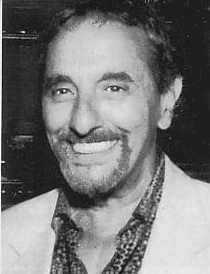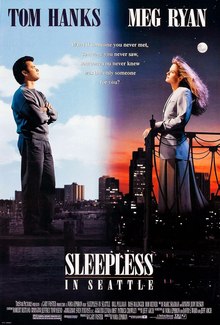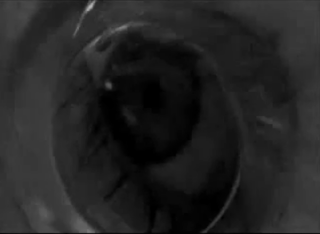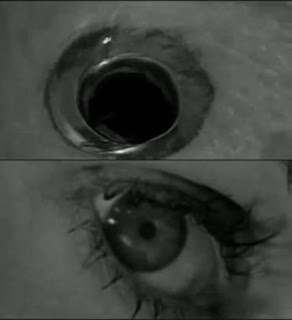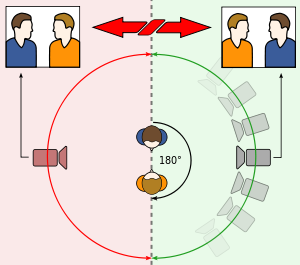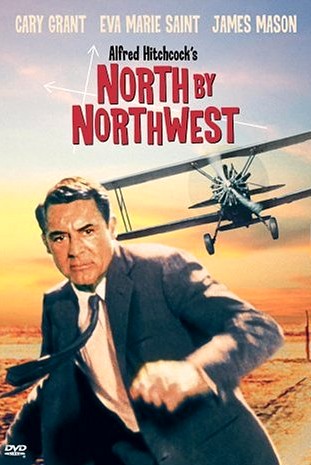 In every Tuesday session we watch an Alfred Hitchcock Thriller.
In every Tuesday session we watch an Alfred Hitchcock Thriller.As an introduction we began with North by Northwest
The Screen-write from Ernest Lehman and Directed by Alfred Hitchcock in 1959 and with great stars such as Cary Grant and Eva Marie Saint as main characters.
A "innocent" New York advertising executive (Cary Grant) is mistaken for a government agent by a group of foreign spies, and is pursued across the country while he looks for a way to survive.
The Trailer
The first thing that grabs your attention in this trailer is the Music this is appealing because the Music sounds mysterious and all-round makes you want to watch more.Also it shows all the main thrilling scenes without telling the viewers what happens next it send a shiver down your spine which allows you to already know the film will be a thriller and the Voice over man also uses word like "sinister"which is thrilling as you cant help but think what else will happen so much information flies your way and over whelms you making you crave the ending.
Archetypal Thriller
- "Thrillers are characterised by fast pacing and frequent action"- this quote applies to North by Northwest because North by Northwest has many scenes such as the plane and the Car Chase as is all Car chases it is fast paced and the music adds frequent tension the fact that shots blend in together is a really good effect because it adds an air of mystery and worry for Cary Grant that he may be injured within such a small amount of the film this also makes us want to watch more as we know Cary Grant is "drunk" and in that case making us curious of how he is going to get out of that situation. I've found a Clip of the scene I meant but unfortunately it is of low quality.
- "Resourceful heroes who must thwart the plans of the more powerful and better equipped villains" - this quote applies to North by Northwest because we consider Cary Grant and in some way Eva Marie Saint a hero although they are caught in tricky situations they seem to over come them for example when they are both in the train and Eva hides Grants character at the top of the cabin as she stole the key from the guard this is seen as heroic because no one expects the woman in the film to be able to do that the Fem fatal is seen as a women who is pretty, she is heroic because she can become a role model, also Cary Grant is heroic as he thwarts the plans of the villain to kill him for example with the plane scene,we see Cary Grant run into a corn field this was him trying to have a disguise so the villains could not trap or see him he chooses the corn field because it was convenient for him and this makes him a hero successfully delaying the villain and not falling for there trap.(The crop duster scene will be analysed further.The clip is bellow)
- "A thriller is a villain driven plot,whereby he presents obstacles the hero must over come" above is the scene to the car chase this applies to this statement because the villain contributes to many obstacles that are designed to trap or harm Cary Grants character as we said earlier the car chase scene is one of the main obstacles Cary Grant faces as he is his own worst enemy if he cannot get control of the car he will die and in that case the film would have been finished before it had even started but luckily the character swerves past the attempts of the villain and makes sure he is caught by the police and steers his car so he doesn't fall down the cliffs surprisingly to the villain.
- "Devices such as suspense, red herrings and cliffhangers are used extensively "- this applies to the North by Northwest as it uses these devices a lot and as all these devices come together to add a lot of effect and complement each other.The best scene to look at for this definition is the auction scene as it has a wide use of all three devices:
- Suspense :The device suspense is used frequently in this scene and throughout the film such as the side road scene and the car chase but as we see in the Auction clip (above) as we see we have the Villain slowly and steadily stroking of Eva's head and then the shot shows the audience very slowly this builds suspense as we wonder When Cary Grants character will appear as he knows the "truth"and then we see that Cary Grant is actually witnessing what is happening,this scene fills us with suspense not only because we want to know when he will appear but it is also gives us the idea of deceit and hurt which makes us wonder how Grants character is going to react.
- Red herrings:A Red herring is a clue that intentionally allows the viewer to be mislead from the main issue the Red herring in this scene is two things first is the character Eva Saint is playing obviously before we thought she was an ally and now in this scene she is with the Villain but then by the end of the film we realise she is actually a Secret agent, but the main Red herring is the fact that they seem to be at a art auction but are actually looking out to by the statue with the drugs in them this counts as a red herring because we believe that although the Villains must be doing something wrong they are just innocently buying/viewing pieces of art but the reality is that they are buying a type of drug this is hidden away from the audience until a little later when we find out there real intentions making this a Red herring Scene.
- Cliffhangers :The Cliffhanger within this scene is that we realise that Cary Grants character has fallen into a trap and we wonder how he will get out of this situation he is in, we realise that the character has fallen in an unintentional trap and has in fact trapped his self this also add to my earlier point that all these devices complement each other in this case suspense and cliffhangers go hand in hand.
- The Crop Duster Scene
The Crop Duster scene is one of the most Iconic action sequences within the film as it has the ability to have all we want in a thriller in the short clip:
- Firstly we see the plane flying by and we consider it just an ordinary plane as does Cary Grants character and then we see that it is really going towards Cary Grant and that whoever is flying the plane is trying to get him, within the small part we get a point of view shot of the pane going toward Grant and this allows us to be in Grants place as if the plane was coming towards us.This builds panic and tension and overall interest in the audience as you want to know what will happen to the character and you would like to know who is in the plane, As point of view shots allow you to see what the character is seeing we truly feel that we have put our "toe in the cold water of fear" because we can put ourselves into that scene and see how we would react.
- As we realise this is an obstacle the Villain has presented to Cary Grants character it builds up the tension we feel,we are already tense from knowing that Grants character is looking for someone by the side of the road and then we see that actually it was a plan to trap or kill Grants character this makings us think that there are forces against Grant and that the villain has an upper hand as does all villains this also leads us to believe that Grant will not be able to get out of the circumstance he is in.
- When analysing a scene we have to take into consider the surroundings and setting the scene takes place, Within North by Northwest there are many good scene settings but looking at the Crop Duster scene there are many factors to the setting that add an effect to the audience first of all earlier than the clip shown there is a very empty road during that scene all you can suspect is for a car to come, the car Grants character is looking for but all there is a dusty side path and a very quiet road this adds to the tense feeling because you expect a high action scene but although it is very slow with little action it still adds tension as if it is slowly creeping into a adrenaline filled scene, There is also the Crop scene where Grants Character hides within the crops this adds an effect as we quickly think of a primal scene and that Grants character is fighting/ hiding for his own safety and survival this effects the audience because we are given the mind set that something very serious is happening and that its so life risking that there is a need to hide but the fact that there is the lone crop field in the middle of no where gives us the idea that Grants character is alone in this world of villains and enemies.
- Then there is the scene where he has to fall on the dusty paths this is an effect as Grants character is a business man and we do not expect him to be in the middle of crops all dusty this is is effective because as I have said in the earlier point it makes him primal and desperate, desperate because he is doing anything to stay safe/alive even if that does mean throwing himself to the floor and getting his clothes dirty
- The Main reason the Crop Duster scene is very iconic is because it has an amazing action scenes that are able to fill you with suspense and slow seeming fast paced action ,First you have the plane throwing the dust bombs , this is an iconic action scene because its is fast paced due to the running of Grants character and the diegetic sound effects coming from the planes motors and the dust bombs and an air of urgency but the Non diegetic sound at the running scene adds a lot of tension. Then there is the scene when the plane crashes into the truck, Grants character seeks an escape and see there on coming truck but the truck is unable to stop causing screeching and the explosion sound as the plane goes into the truck. Overall this is a thrilling scene made to make our hearts beat outside our chest
MacGuffin is "a plot element that catches the viewers attention of drives the plot of a work of fiction."The defining aspect of a MacGuffin is that the major characters in the story are (at least initially) willing to do and sacrifice almost anything to obtain it, regardless of what the MacGuffin actually is.In fact,the specific nature of the MacGuffin may be ambiguous, undefined ,generic,left to open to interpretation or otherwise completely unimportant to the plot examples of an MacGuffin is money ,glory,survival,a source of power,or a potential threat, or it might be something totally unexplained.A MacGuffin is common in films and especially thrillers.commonly,though not always ,the MacGuffinis the central focus of the film in the first act ,and then declines in importance as the struggles and motivations of the characters play out.It may come back into play at the climax of the story, but sometimes the MacGuffin is actually forgotten by the end of the film.In TV interviews Hitchcock defined the a MacGuffin as the object around which the plot revolves but, as to what that object specifically is,he declared "the audience doesn't care".In North by Northwest's case we could say the MacGuffin what the Villains are in possession of which is the drugs.
Alfred Hitchcock said Thrillers allow the Audience "to put their toe in the cold water of fear to see what its like" Alfred Hitchcock successfully achieves this within every thriller film he has made but within North by Northwest he does in the scenes above and the cliff hanger scene, and with his many different devices.
While watching an interview of Alfred Hitchcock it seems his philosophy is that thrillers are meant to be dreamlike and even a nightmare but real enough to shock and scare as if it could actually happen,He also believed that narratives made the storyline /thriller more smooth for the audience to catch on but a dream would be disjointed, I understand Hitchcock's theory on this as if you have a daunting dream sometimes the person dreaming cant even make sense or even understand it as Alfred Hitchcock wanted to make thrillers able in reality he had to make them a narrative. A strong device he mentions in his interview is avoiding a cliché this is the most effective device Hitchcock could possibly use as whatever thriller we look at you don't expect the ending from the films that we actually have watched the strongest film we have seen with this factor was psycho, the ending was totally unexpected as throughout the film you
are led to believe that the character is still alive,Within the clip below Alfred Hitchcock explains how he made this scene seem like a cliché but more like reality within 3:44 and 7:40.
This clipped interview is beautiful because you can see the amount of passion within his answers an explanation of his devices such as Mystery, defying cliché and suspense.
Alfred Hitchcock said Thrillers allow the Audience "to put their toe in the cold water of fear to see what its like" Alfred Hitchcock successfully achieves this within every thriller film he has made but within North by Northwest he does in the scenes above and the cliff hanger scene, and with his many different devices.
While watching an interview of Alfred Hitchcock it seems his philosophy is that thrillers are meant to be dreamlike and even a nightmare but real enough to shock and scare as if it could actually happen,He also believed that narratives made the storyline /thriller more smooth for the audience to catch on but a dream would be disjointed, I understand Hitchcock's theory on this as if you have a daunting dream sometimes the person dreaming cant even make sense or even understand it as Alfred Hitchcock wanted to make thrillers able in reality he had to make them a narrative. A strong device he mentions in his interview is avoiding a cliché this is the most effective device Hitchcock could possibly use as whatever thriller we look at you don't expect the ending from the films that we actually have watched the strongest film we have seen with this factor was psycho, the ending was totally unexpected as throughout the film you
are led to believe that the character is still alive,Within the clip below Alfred Hitchcock explains how he made this scene seem like a cliché but more like reality within 3:44 and 7:40.
This clipped interview is beautiful because you can see the amount of passion within his answers an explanation of his devices such as Mystery, defying cliché and suspense.


